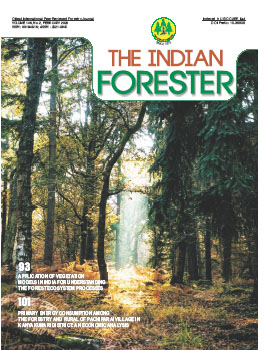Application of Vegetation Models in India for Understanding the Forest Ecosystem Processes
DOI:
https://doi.org/10.36808/if/2020/v146i2/151208Keywords:
Climate Change, DGVM, Forest Management, Plant Functional Type, Simulation, Vegetation Modelling.Abstract
Forest ecosystems are one ofthe complex systems that provide essential goods and services to support human survival. Various processes of a forest ecosystem are interlinked to each other to make the system complex and unique. Researchers have been striving to understand the interlinked processes to manage the forests in a sustainable manner. The growing interests ofresearchers in understanding the physical structure and the functioning of forests has attracted the attention of other disciplines of science. As a result, forestry research has been supported by other emerging disciplines such as the use of remote sensing, geographical information system, bioinformatics, machine learning, advanced analytics, simulation, etc. The development and testing of vegetation models is one of the discipline that integrates the application of ever emerging new advance tools. Researchers have been making the effort to represent the physical and physiological characteristics of forests in a virtual environment using computers. This has paved the way for the development of various algorithms and models using computers. Models provide an opportunity to visualize a system in a simplistic way which is otherwise complex. The authors present here various features ofmodels used in forestry, the present generation of dynamic global vegetation models, opportunities and limitations of using models, the need for future research and initiatives by Forest Research Institute (FRI), Dehradun in the application and development of vegetation models.References
Aggarwal P.K., Kalra N., Chander S. and Pathak H. (2006). InfoCrop: a dynamic simulation model for the assessment of crop yields, losses due to pests, and environmental impact of agro-ecosystems in tropical environments. I. Model description. Agriculturalsystems, 89(1): 1-25.
Bachelet D., Lenihan J.M., Daly C., Neilson R.P., Ojima D.S. and Parton W.J. (2001). MC1: a dynamic vegetation model for estimating the distribution ofvegetation and associated ecosystem fluxes of carbon, nutrients, and water. Pacific Northwest Station General Technical Report PNW-GTR-508.
Bonan G.B. (1996). Land surface model (LSM version 1.0) for ecological, hydrological, and atmospheric studies: Technical description and users guide. Technical note. National Centerfor Atmospheric Research, Boulder, CO (United States). Climate and Global Dynamics Div.
Brovkin V., Ganopolski A. and Svirezhev Y. (1997). A continuous climate-vegetation classification for use in climate-biosphere studies. Ecological Modelling, 101(2-3): 251-261.
Champion H.G. and Seth S.K. (1968). A Revised Survey of the Forest Types of India. Government of India Publication. New Delhi.
Chaturvedi R.K., Gopalakrishnan R., Jayaraman M., Bala G., Joshi N.V., Sukumar R. and Ravindranath N.H. (2011). Impact of climate change on Indian forests: Adynamic vegetation modeling approach. Mitigation and Adaptation Strategies for Global Change, 16(2): 119-142.
Cox PM. (2001). Description of the TRIFFID dynamic global vegetation model. Hadley Centre technical note, 24: 1-16.
Foley J.A., Prentice I.C., Ramankutty N., Levis S., Pollard D., Sitch S. and Haxeltine A. (1996). An integrated biosphere model of land surface processes, terrestrial carbon balance, and vegetation dynamics. Global Biogeochemical Cycles, 10(4): 603-628.
Franklin J., Davis F.W., Ikegami M., Syphard A.D., Flint L.E., Flint A.L. and Hannah L. (2013). Modeling plant species distributions under future climates: howfine scale do climate projections need to be? Global change biology, 19(2): 473-483.
Friend A.D., Stevens A.K., Knox R.G. and Cannell M.G.R. (1997). A process-based, terrestrial biosphere model of ecosystem dynamics (Hybrid v3. 0). Ecological Modelling, 95(23): 249-287.
Gopalakrishnan R., Jayaraman M., Swarnim S., Chaturvedi R.K., Bala G. and Ravindranath N. H. (2011). Impactof climate change at species level: a case study of teak in India. Mitig. Adapt. Strateg. Glob. Chang., 16(2): 199-209.
Kalra N. and KumarM. (2019). Simulating the Impactof Climate Change and its Variability on Agriculture. In S. Sheraz Mahdi (Ed.), Climate Change and Agriculture in India: Impact and Adaptation (pp. 2128). Cham: Springer International Publishing.
Kucharik C.J., Foley J.A., Delire C., Fisher V.A., Coe M.T., Lenters J.D., Young-Moiling C. and Ramankutty N. (2000). Testing the performance of a dynamic global ecosystem model: Water balance, carbon balance, and vegetation structure. Global Biogeochemical Cycles, 14(3): 795-825.
Kumar M. (2018). Analysing impacts ofclimate change on forests of Uttarakhand using dynamic vegetation model. (Unpublished doctoral dissertation). Forest Research Institute Deemed to be University, Dehradun, Uttarakhand (India).
Kumar M., Kalra N., Khaiter P., Ravindranath N.H., Singh V., Singh H., Sharma S. and Rahnamayan S. (2019). Pheno Pine: A simulation model to trace the phenological changes in Pinus roxhburghii in response to ambient temperature rise. Ecological Modelling, 404:12-20.
Kumar M., Rawat S.P.S., Singh H., Ravindranath N.H. and Kalra N. (2018). Dynamic forest vegetation models for predicting impacts of climate change on forests: An Indian perspective. Indian Journal of Forestry, 41(1): 1-12.
Levis S., Bonan B., Vertenstein M. and Oleson K. (2017). The community land modeL's dynamic global vegetation model (CLM-DGVM): technical description and user's guide.
Peng C. (2000). From static biogeographical model to dynamic global vegetation model: a global perspective on modelling vegetation dynamics. Ecological Modelling.
Running S. (1992). A bottom-up evolution of terrestrial ecosystem modeling theory, and ideas toward global vegetation modeling. University Corp, for Atmospheric Research, Modeling the Earth System, 3: 263-280.
Sitch S., Smith B., Prentice I.C., Arneth A., BondeauA., Cramer W., Kaplan J.O., Levis S., Lucht W. and Sykes M.T. (2003). Evaluation of ecosystem dynamics, plant geography and terrestrial carbon cycling in the LPJ dynamic global vegetation model. Global Change Biology, 9(2): 161-185.
Upgupta S., Sharma J., Jayaraman M., KumarV. and Ravindranath N.H. (2015). Climate change impact and vulnerability assessment of forests in the Indian Western Himalayan region: A case study of Himachal Pradesh, India. Clim. Risk Manag., 10: 63-76.
Woodward F.I. and Cramer W. (1996). Plant functional types and climatic change: introduction. Journal of Vegetation Science, 7(3): 306-308.
Downloads
Downloads
Published
How to Cite
Issue
Section
License
Unless otherwise stated, copyright or similar rights in all materials presented on the site, including graphical images, are owned by Indian Forester.





